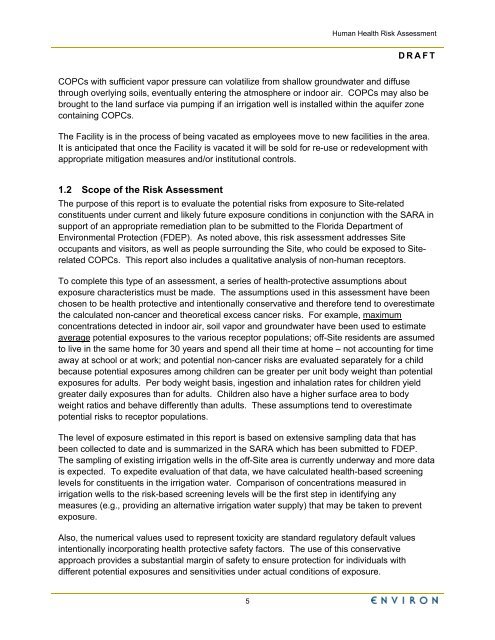Human Health Risk Assessment - Raytheon
Human Health Risk Assessment - Raytheon
Human Health Risk Assessment - Raytheon
Create successful ePaper yourself
Turn your PDF publications into a flip-book with our unique Google optimized e-Paper software.
5<br />
<strong>Human</strong> <strong>Health</strong> <strong>Risk</strong> <strong>Assessment</strong><br />
DRAFT<br />
COPCs with sufficient vapor pressure can volatilize from shallow groundwater and diffuse<br />
through overlying soils, eventually entering the atmosphere or indoor air. COPCs may also be<br />
brought to the land surface via pumping if an irrigation well is installed within the aquifer zone<br />
containing COPCs.<br />
The Facility is in the process of being vacated as employees move to new facilities in the area.<br />
It is anticipated that once the Facility is vacated it will be sold for re-use or redevelopment with<br />
appropriate mitigation measures and/or institutional controls.<br />
1.2 Scope of the <strong>Risk</strong> <strong>Assessment</strong><br />
The purpose of this report is to evaluate the potential risks from exposure to Site-related<br />
constituents under current and likely future exposure conditions in conjunction with the SARA in<br />
support of an appropriate remediation plan to be submitted to the Florida Department of<br />
Environmental Protection (FDEP). As noted above, this risk assessment addresses Site<br />
occupants and visitors, as well as people surrounding the Site, who could be exposed to Siterelated<br />
COPCs. This report also includes a qualitative analysis of non-human receptors.<br />
To complete this type of an assessment, a series of health-protective assumptions about<br />
exposure characteristics must be made. The assumptions used in this assessment have been<br />
chosen to be health protective and intentionally conservative and therefore tend to overestimate<br />
the calculated non-cancer and theoretical excess cancer risks. For example, maximum<br />
concentrations detected in indoor air, soil vapor and groundwater have been used to estimate<br />
average potential exposures to the various receptor populations; off-Site residents are assumed<br />
to live in the same home for 30 years and spend all their time at home – not accounting for time<br />
away at school or at work; and potential non-cancer risks are evaluated separately for a child<br />
because potential exposures among children can be greater per unit body weight than potential<br />
exposures for adults. Per body weight basis, ingestion and inhalation rates for children yield<br />
greater daily exposures than for adults. Children also have a higher surface area to body<br />
weight ratios and behave differently than adults. These assumptions tend to overestimate<br />
potential risks to receptor populations.<br />
The level of exposure estimated in this report is based on extensive sampling data that has<br />
been collected to date and is summarized in the SARA which has been submitted to FDEP.<br />
The sampling of existing irrigation wells in the off-Site area is currently underway and more data<br />
is expected. To expedite evaluation of that data, we have calculated health-based screening<br />
levels for constituents in the irrigation water. Comparison of concentrations measured in<br />
irrigation wells to the risk-based screening levels will be the first step in identifying any<br />
measures (e.g., providing an alternative irrigation water supply) that may be taken to prevent<br />
exposure.<br />
Also, the numerical values used to represent toxicity are standard regulatory default values<br />
intentionally incorporating health protective safety factors. The use of this conservative<br />
approach provides a substantial margin of safety to ensure protection for individuals with<br />
different potential exposures and sensitivities under actual conditions of exposure.

















